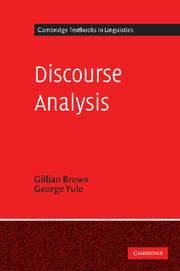Book contents
- Frontmatter
- Contents
- Preface
- Acknowledgements
- Transcription conventions
- 1 Introduction: linguistic forms and functions
- 2 The role of context in interpretation
- 3 Topic and the representation of discourse content
- 4 ‘Staging’ and the representation of discourse structure
- 5 Information structure
- 6 The nature of reference in text and in discourse
- 7 Coherence in the interpretation of discourse
- References
- Subject index
- Author index
6 - The nature of reference in text and in discourse
Published online by Cambridge University Press: 05 June 2012
- Frontmatter
- Contents
- Preface
- Acknowledgements
- Transcription conventions
- 1 Introduction: linguistic forms and functions
- 2 The role of context in interpretation
- 3 Topic and the representation of discourse content
- 4 ‘Staging’ and the representation of discourse structure
- 5 Information structure
- 6 The nature of reference in text and in discourse
- 7 Coherence in the interpretation of discourse
- References
- Subject index
- Author index
Summary
In the last chapter we were largely concerned with considering the structure of small formal chunks of language, particularly nominal expressions, and exploring the ways in which particular forms in English have come to be associated with a particular information status. These formal structures constitute cues for the hearer / reader as to how the speaker / writer intends the discourse to be interpreted.
We begin this chapter by considering how large chunks of language come to be interpreted as texts. We examine the formal expressions, some of which were discussed in Chapter 5, which are available to the speaker / writer as cues to signal explicitly how parts of the discourse are to be interpreted, particularly anaphoric expressions. We then go on to consider the central question of what it means to refer in discourse.
What is ‘text’?
We have proceeded in this book with the rather simple account of what constitutes a text which we gave, with accompanying caveats, in Chapter 1. Text, we said, is the verbal record of a communicative event. A number of authors have been concerned to provide a tighter, more formal account of how speakers of English come to identify a text as forming a text (cf. for example van Dijk, 1972; Gutwinski, 1976; de Beaugrande, 1980; de Beaugrande & Dressier, 1981; Halliday & Hasan, 1976.)
Information
- Type
- Chapter
- Information
- Discourse Analysis , pp. 190 - 222Publisher: Cambridge University PressPrint publication year: 1983
